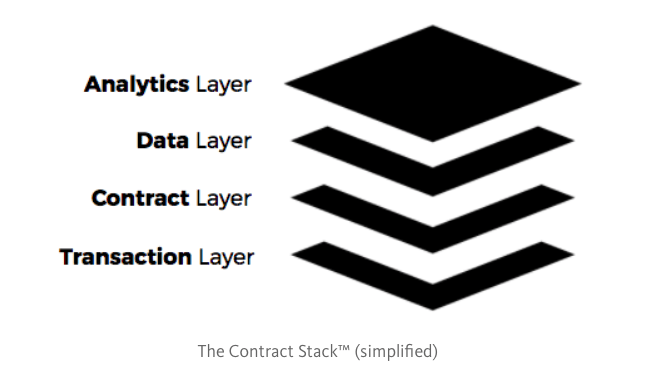
This is a Guest Post by Peter Hunn, co-founder of New York-based dynamic contract start-up, Clause.io.

Readers may remember Clause launched last year with a focus on linking IoT technology, such as sensors, to digitally-based contracts to create what has been called ‘dynamic contracts’ that can alter as external, physical conditions change. These are seen as especially useful in areas where environmental factors could lead to the terms of a contract needing to change, such as with trade and transportation.
Clause has been busy since then and has been exploring a new concept that they call ‘the contract stack’, a play on the term ‘software stack’. Or as Clause puts it: ‘We firmly believe that the contract must transition from a static, manually managed entity, to one that is dynamic, self-managing and seamlessly integrated into business processes.’
Sounds intriguing. So, what better way to explain what this all means than to hear from the company itself. Enjoy.
Reinventing the Legal Contract
Now, we all know that ‘software is eating the world‘, often in waves at a time. The rise of fintech has been the big story over the past decade. Today, we are really at the beginning of this in legal, which has to date remained relative untouched compared to other industries.
It is difficult to conceive of anything as fundamental as the contract that has, comparatively, gone through so little technical innovation. Think about your autonomous vehicle and its PDF insurance policy. Contracts are the core of commerce and need to keep apace!
Excluding contract lifecycle management (CLM) software, there have been three major technical phases affecting the nature and management of the contract:
(1) PDFs > (2) e-signature > (3) NLP/AI/DLT
The impact of the first two are obvious. The ability to transmit documents with reduced risk of unauthorised changes, independently of software constraints, and without the ‘price-sign-scan-email’ circus, vastly improved the management of contracts and commercial transactions.
The third enables data derived from the natural language within contracts to be extracted and analysed quickly; making review far less resource intensive. It is here where Kira, RAVN and fellow Seedcamp portfolio company, Beagle.ai , are working. The majority of innovation in contract technology is currently around this area in some form.
The Idea of a Contract Stack*
A software stack is ‘a set of software subsystems or components needed to create a complete platform such that no additional software is needed to support applications’ (Wikipedia). Software has reinvented every facet of society. As such, the commercial world is changing, and contracts need to fundamentally change too. Not a paper document in a drawer, a PDF in Dropbox or stored on CLM software.
We firmly believe that the contract must transition from a static, manually managed entity, to one that is dynamic, self-managing, and seamlessly integrated into business processes. This will only occur by enabling contracts to interface with data, auto-reconcile with other systems, perform transactions, provide real-time feedback and analysis to users, and integrate with other enterprise data.
Let’s look at a very basic example: a PDF sales contract is negotiated and signed for 1000 widgets and then stored in electronic form (maybe CLM software to derivatively manage workflows relating to those ‘paper/PDF’ documents). But this doesn’t really give us anything except that we agreed to purchase the widgets, for delivery at a certain time, and often with certain warranties about widget quality. No truly valuable data about contract performance or state. No automation. No interaction between the contract and the physical world.
But what if we knew when the widgets would arrive, and thus if there were delays in delivery and the effect these have on our ability to fulfill downstream contracts in which we use the widgets? What if too few widgets were delivered? What if we only paid what we were obligated to pay and didn’t need to manage credit notes? What if our accounting and ERP systems knew the exact state of our sales contract and we could build that into management, in real-time.
What if we could run analysis on our widget contract and contracts that depend upon it to identify and solve issues? Now apply that to thousands, if not hundreds of thousands of contracts of all types. The efficiencies, financial benefits, risk mitigation, resources saved, asset utilisation rates, and improvement in commercial decision-making is truly staggering.
This is not just a series of ‘what ifs’. It’s possible by re-imagining what a contract is, and here at Clause we have done just that by building the ‘Contract Stack’, which is a series of modular software components that will begin to replace the paper/PDF contract we know today.

In many ways, we see analogies between our approach and the transition from paper checks (current legal contracts) to API-based financial transactions provided by the likes of Stripe and Square (future legal contracts). Right now, we are probably (but very loosely) at the ‘e-check‘ stage: paper contracts that can be signed electronically but still need to be administered manually (why its not a perfect analogy…oh well).
This, at least, puts it into context — the contract is so fundamental to commerce yet it really doesn’t serve its purpose that well when we put it into the wider innovation context. Clause and the Contract Stack will change that and the very nature of the contract. [Editor: Bold claim alert.]
(* Note: It seems that Clause has trademarked the term ‘Contract Stack’, FYI.)
1 Trackback / Pingback
Comments are closed.